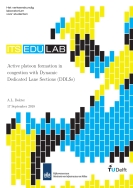In order to find a solution for congestion many studies research and implement automated driving (AD). This research considers connected and automated vehicles (CAVs) as a prime candidate for this solution. CAVs are able to drive in platoons with small inter-vehicle time gaps. CAV platoons with small inter-vehicle time gaps can increase the throughput on the motorway, however before this will occur a high penetration rate is deemed necessary. This research described in this report is meant to look at the implementation of CAVs when the penetration rate is still low, this is the case at initial deployment. The problem with CAVs platooning on the motorway with a low penetration rate, is that the actual formation of platoons is hard to achieve due to mixed traffic conditions. Mixed traffic conditions are conditions that have “normal” (human driven) vehicles and CAVs present on the motorway network. In these conditions the conventional vehicles block the CAVs and prohibit them to form platoons on the motorway. On the other hand the congested conditions prohibit the CAVs to form platoons alongside the motorway. This would require the CAVs to merge back onto the motorway, which would increase the congestion. Therefore, the objective that this research tries to obtain, is stated as: “Develop platoon formation strategies that allow the CAVs to form platoons on the motorway in mixed and congested traffic, without deteriorating the traffic conditions.” To test whether or not this objectives is obtained the research was build up out of two elements: 1. developing a new strategy and 2. performing simulation experiments to test the effects the developed strategies have on the traffic conditions.
With the method of prototyping two platoon formation strategies have been developed, both strategies are based on the same foundation. The two different platoon formation strategies are: “an activation strategy with an one-time density threshold check” and “an activation strategy with a permanent density threshold check”. The platoon formation strategies apply dynamic dedicated lane sections (DDLSs) in order to let CAVs platoon on the road in congested and mixed traffic conditions. To test the effects of the developed strategies a simulation experiment with 21 different scenarios was created. In this experiment three types of variables are determined: the independent variables, the control variables and the dependant variables also known as the key performance indicators (KPIs). For the simulations the MOTUS model was used, developed at Delft University of Technology for this type of applications.
The results show that the active platoon formation strategies work as they were intended, they actively form platoons while the capacity drop does not increase. However time spent in the system for the conventional vehicles in the congestion does deteriorate (per vehicles on average 200 seconds). This does not seem a lot and the CAV platoons will probably stabilise traffic conditions further downstream, since they are platooning with small inter-vehicle time gaps. However, the perception of the driver in the conventional vehicle might be different. They would see moving vehicles, while they are stuck in a slow moving traffic jam. This might instigate the drivers and they could disregard the restriction on the left lane. This would not only make the strategies inefficient, it could also be dangerous (e.g. rear-end collisions).
